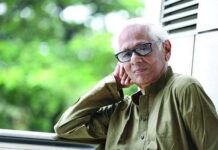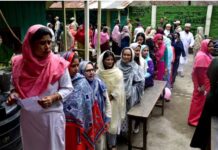by
From across the lake, we watched them dig the foundations. We thought, at the time, that it would look like any other house, albeit with a bit more lake frontage than most. Then, as the scaffolding went up, and the building took shape, we realized it wasn’t going to be an ordinary house at all, but that rare thing: a landmark — and an architectural monstrosity.
It was 1993 and my parents and I had recently returned to Dhaka, Bangladesh, after 14 years abroad, most recently in Bangkok. With the promise of a new life in our old hometown, we moved into my grandfather’s house, where two of my uncles lived with their wives and children. The house, built in 1964, was a sprawling, two-story brick building, with a flat cement roof and a wide wraparound balcony. The kitchen was in an outbuilding, down a few steps and across an open drain into which one uncle would blow his nose every morning.
In the backyard, which was wild and unmown, my cousins and I pretended to shoot things with imaginary guns. In the evenings, the air was thick with mosquitoes.
Dhaka was then still a rather sleepy metropolis. You could get across town, between Dhanmondi, where we lived, to Gulshan, the diplomatic enclave on the northern fringe, in about 20 minutes. After Bangkok, where the traffic and pollution were much worse, Dhaka seemed bucolic, even neat, by comparison.
But in the early ’90s, everything began to change. The house across the lake was a sign of things to come.
It was about six stories high and irregularly shaped. Multiple roofs cascaded from its peaks, making the front of the building resemble the hide of a rhinoceros, from which a tall, pointy obelisk was raised. It was only after the red tiles had been placed on the facade that we realized the pointy thing was a minaret.
The building was a strange pastiche of the sacred and the secular, for the rest of it looked like a ship, with the outer boundary wall shaped like a curved hull and the roofs looking like sails in the wind. The neighbors nicknamed it Jahaj Bari (the Ship House).
Urban myths about it sprouted. We heard that it belonged to Sher-e-Khwaja, a self-styled holy man and philanthropist who had amassed a huge fortune no one knew quite how, and who was rumored to have deep political connections. No one I knew had ever been inside the building, which was said to have 40 bedrooms.
In the meantime, the landscape of Dhaka was rapidly changing. The roughly 100 square miles of the city were not enough for a growing metropolis, but instead of expanding out and creating suburbs, the city planners gave permission to landowners in 1996 to build six-story apartment buildings on their residential plots. Commercial permits soon followed, and those who were lucky enough to own a piece of land on a main road were able to build shopping malls and office buildings on their property.
This is what happened with my grandfather’s house. In 1999, the family made the decision to tear down the broad, low-slung building; in its place a shopping mall and an apartment building sprang up. My father and his four brothers each got two apartments. Uncles, aunts, cousins, their wives and children all moved into this building, an extended family bifurcated now by stairwells and separate entrances.










